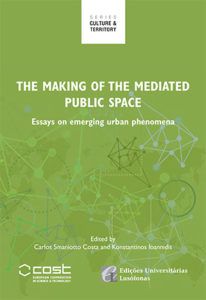Culture & Territory
Vol.02 - The Making Of The Mediated Public Space. Essays on emerging urban phenomena

- Vol.02 – The Making Of The Mediated Public Space. Essays on emerging urban phenomena
- Carlos Smaniotto Costa & Konstantinos Ioannidis - Authors & Editors
- 2017
- ISBN 978-989-757-059-9 | ISSN 2184-8009
- DOI: https://doi.org/10.24140/2020-sct-vol.4
Synopsis
The essays of this book discuss a series of reflections related to space and outdoor digital technologies – the so called Mediated Public Open Space. Thirty international authors and researchers engage in the nexus people, places and technology from different positions and perspectives. They shed light to emerging socio-spatial and technical mechanisms and the multiplicity of interaction of humans with urban spaces intertwined by contemporary pervasive technologies. Can the Mediated Public Open Space enable new interactive experiences? Can it lead to innovative realities where the community celebrate publicness enlivening the public realm? These are some questions posed in this volume and the essays that follow attempt to provide food for thought towards increasing the understanding of public spaces in the postdigital era.
Smaniotto Costa, Carlos and Ioannidis, Konstantinos (Eds.) (2017). The making of the mediated public space – Essays on emerging urban phenomena. CyberParks Project. Culture & Territory, volume 2. Lisbon: Lusófona University Press. 253 Pages. http://cyberparks-project.eu/publications
Table of Contents
Foreword – The Mediated Public Space – an emerging urban phenomenon
Konstantinos Ioannidis, Carlos Smaniotto Costa. pages 7-12
Acknowledgment. pages 13-14
Part I: Co-Creating Inclusive And Mediated Places
1.1 A framework for defining principles for inclusive mediated public spaces
Carlos Smaniotto Costa. page 17-24
1.2 Design principles for co-creating inclusive and digitally mediated public spaces
Francesco Bagni, Iva Bojic, Tiago Duarte, Joatan Preis Dutra, Scott Gaule, Adam van Heerden, Isidora Karan, Maria Kikidou, Athanasia Panagiotidi and Artemis Psaltoglou pages 25-40
1.3 Technologies of anthropogenic spaces: co-creation aspects in co-mediated landscapes
Konstantinos Ioannidis. page 41-54
1.4 Smart cities and the re-invention of the Panopticon
Catarina Patrício. pages 55-64
1.5 Walking as a tactile method in urban planning and design
Marluci Menezes, Diogo Mateus. pages 65-74
1.6 Creative landscapes: co-creating inclusive, mediated cultural and creative spaces. The Marche Region case study
Monica Bocci. pages 75-84
1.7 Inclusive design and digital experiences in public spaces
Tatiana Ruchinskaya. pages 85-96
1.8 Understanding urban public open spaces and co-creation
Ina Šuklje Erjavec. pages 97-108
1.9 Insights on the use of public spaces: leisure behaviours of young professionals and the role of digital technologies
Monica Bocci, Carlos Smaniotto Costa. pages 109-119
Part II: The Failed And The Enhanced: Mediated Urban Landscapes
2.1 Acknowledging immaterial things: from allographic systems to enhanced places
Konstantinos Ioannidis. pages 123-130
2.2 Planning the cultural and social reactivation of mediated urban environments: Democracy and urban policies in the Greek context
Eleni Oureilidou. pages 131-150
2.3 From ‘failure’ to commons? Teenagers in collective management of urban green
Paschalis A. Arvanitidis. pages 151
2.4 Building a theory on co-creating a Cyberpark: lessons learnt from the COST Action CyberParks and the Flussbad Project, Berlin
Carlos Smaniotto Costa, Jan Bovelet, Kai Dolata, Marluci Menezes. pages 165-174
2.5 Process of making the hearth of the neighbourhood: from analogue to digital public space design
Milena Vukmirović, Aleksandra Djukić pages 175-188
2.6 Gotta enhance’em all: a case study of two Pokemon GO enhanced urban spaces in Aalborg, Denmark
Simon Wind, Line Marie Bruun Jespersen, Markus Löchtefeld and Jacob Davidsen. pages 189-200
2.7 Contemporary principles for the project of the mediated space: from the virtual sphere to the spatial experience in the metro’s network of Oporto’s
Trindade Station. Juan Luis Rivas Navarro, Belén Bravo Rodríguez. pages 201-212
2.8 Developing collective intelligence in web mediated environments
Aelita Skarzauskiene . pages 213-230
2.9 Application of ICT to enhance the programmes of public greenery on the example of the New Waterfront in Thessaloniki, Greece: a workshop report
Kinga Kimic . pages 231-242
Notes on Contributors. pages 243-250


